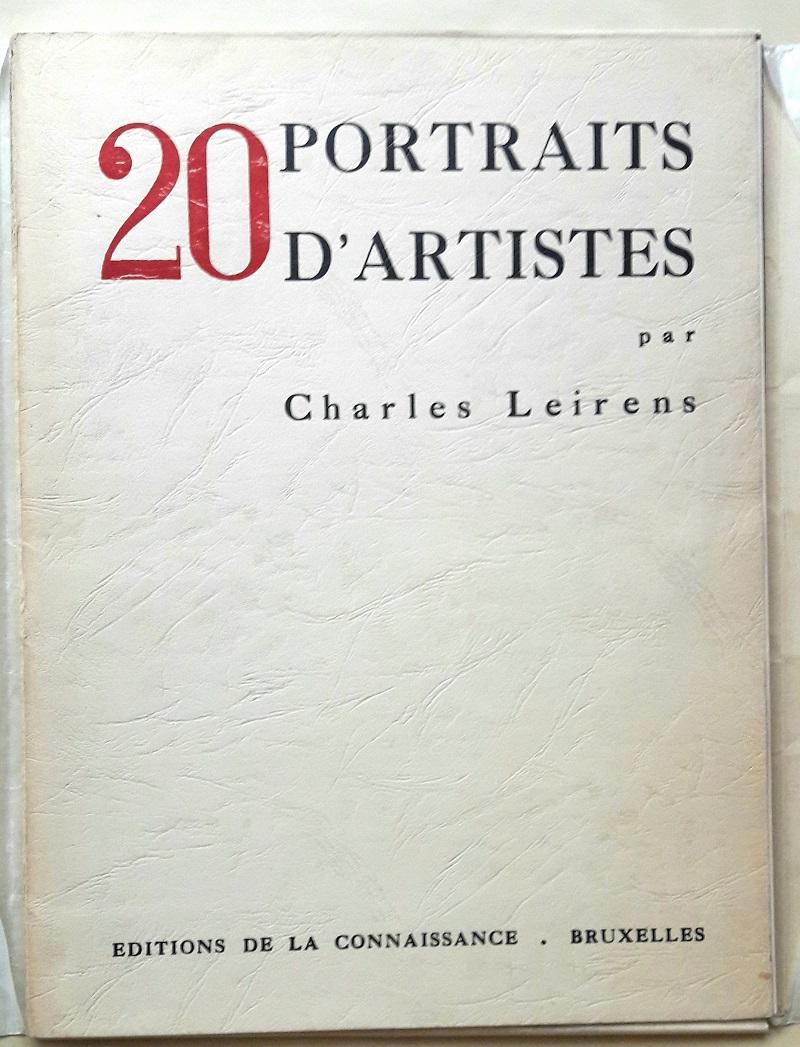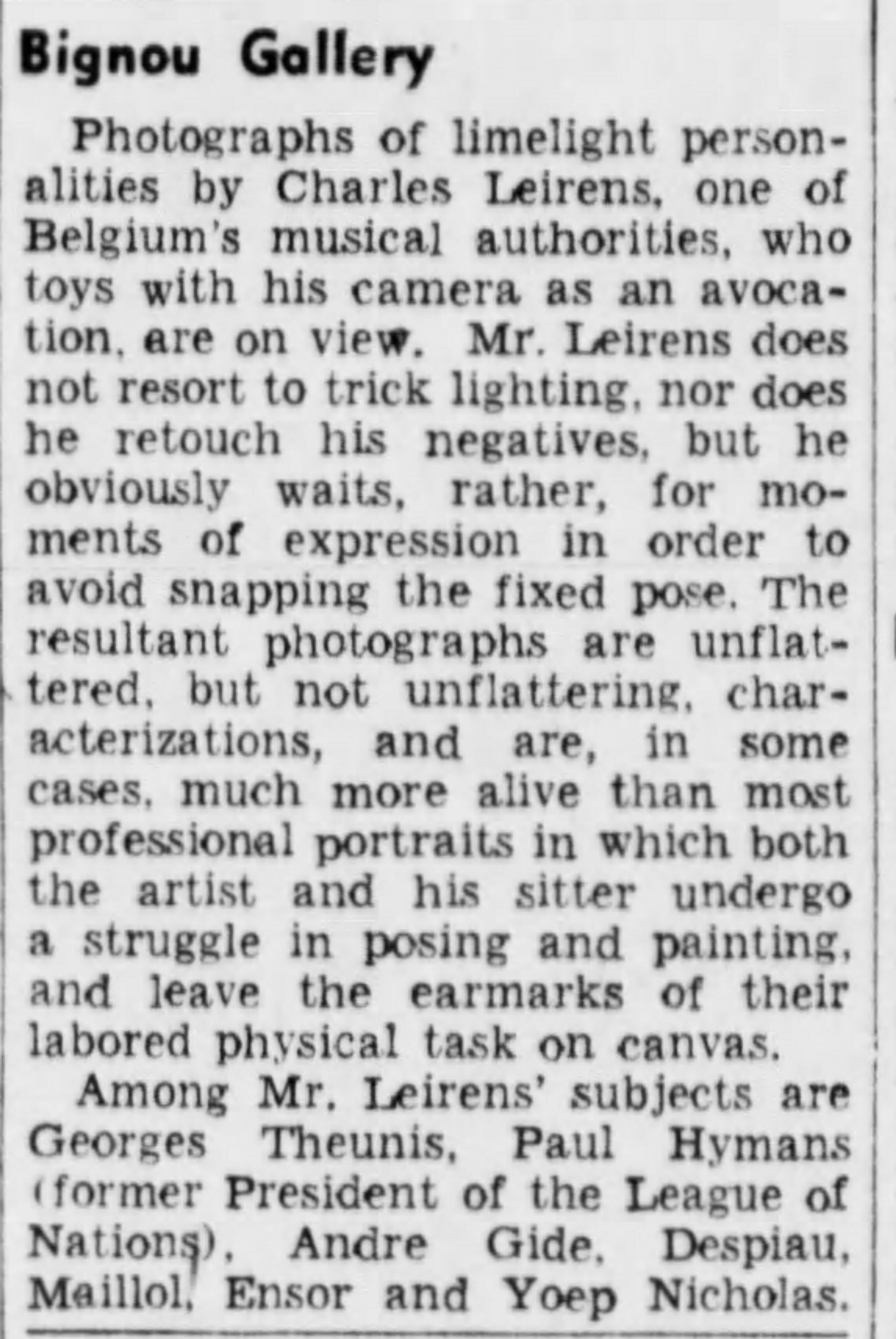Archive
Charles Leirens
- Charles
- Leirens
- 04-03-1888
- Gent (BE)
- 11-04-1963
- Brussels (BE)
- PhotographerMusicianMusicologist
Charles Leirens was a Belgian-born musician and photographer who emigrated to New York in 1941. While publishing two books on Belgian music, he also gave courses in musicology and photography at the New School for Social Research.
Word Count: 36

Announcement for “Photography with the Miniature Camera” course by Charles Leirens. New School Bulletin. Art Classes 1951/1952, vol. 9, no. 2, p. 33 (© New School course catalog collection, NS-05-01-01. The New School Archives). 
Fritz Neugass. “The saga of the S.S. Winnipeg.” Modern Photography, July 1951, pp. 72–73 (Photo: Helene Roth). 
Cover of photobook 20 Portraits d’artistes by Charles Leirens (Editions de la Connaissance, 1936). 
Announcement for the Photographic Portraits of Prominent Europeans by Charles Leirens exhibition at the Bignou Gallery, published in The Brooklyn Daily Eagle, 10 October 1943, p. 16. 
Article on Photographic Portraits of Prominent Europeans by Charles Leirens exhibition at the Bignou Gallery, published in The Brooklyn Daily Eagle, 17 October 1943, p. 32. 
Announcement for “Portraiture with the Miniature Camera” course by Charles Leirens.New School Bulletin. Art Classes 1947/1948, vol. 5, no. 2, p. 29 (© New School course catalog collection, NS-05-01-01. The New School Archives). 
Flyer for Morocco by Charles Leirens exhibition at the New School for Social Research from 27 January to 18 February, 1949 (© New School Publicity Office Records. The New School Archives and Special Collections). Anonymous. "Bignou Gallery." The Brooklyn Daily Eagle, 17 October 1943, p. 32.
Anonymous "Elected by Goucher Classes." Pittsburgh Post-Gazette, 10 March 1945, p. 5.
Charles Leirens. Retrospective, exh. cat. Palais des Beaux-Arts, Brussels, 1964.
Leirens, Charles. 20 Portraits d’artistes. Editions de la Connaissance, 1936.
Leirens, Charles. Belgian Music. Belgian Government Information Center, 1943.
Leirens, Charles. Belgian Folklore. Belgian Government Information Center, 1947.
Neugass, Fritz. “The saga of the S.S. Winnipeg.” Modern Photography, July 1951, pp. 72–75, 86, 88.
New School Bulletin. Art Classes 1947/1948, vol. 5, no. 2.
New School Bulletin. Art Classes 1951/1952, vol. 9, no. 2.
Word Count: 79
New York City, US (1941–1952).
358 East 69th Street, Lennox Hill, New York City (1941–1952).
- New York
- Helene Roth. "Charles Leirens." METROMOD Archive, 2021, https://archive.metromod.net/viewer.p/69/2948/object/5138-9603695, last modified: 10-09-2021.
-
Kurt SafranskiPicture AgentFounding MemberTeacherCartoonistPublisherIllustratorNew York
Kurt Safranski was one of the founding members of the Black Star photo agency, a teacher at the New School for Social Research and the author of photojournalistic articles and books.
Word Count: 31
Josef BreitenbachPhotographerNew YorkOn arriving in New York in 1941, the German photographer Josef Breitenbach tried to restart as a portrait, street and experimental photographer, as well as a teacher of photo-history and techniques.
Word Count: 30
Lisette ModelPhotographerNew YorkLisette Model was an Austrian-born photographer who lived in New York with her husband Evsa Model after emigrating from France. Her street photographs capturing the curiosities of everyday life quickly caught the interest of museums and magazines.
Word Count: 37
Fred SteinPhotographerLawyerNew YorkAlways accompanied by his camera, the German émigré photographer Fred Stein discovered New York City during the 1940s and 1950s. His pictures provide an human and multifaceted view of the metropolis.
Word Count: 31
Alexey BrodovitchPhotographerArt DirectorGraphic DesignerNew YorkAlexey Brodovitch was a Belarus-born émigré graphic artist, art director and photographer who, from 1933, worked in New York for Harper’s Bazaar magazine and at the New School for Social Research.
Word Count: 31
Rolf TietgensPhotographerEditorWriterNew YorkRolf Tietgens was a German émigré photographer who arrived in New York in 1938. Although, in the course of his photographic career, his artistic and surrealist images were published and shown at exhibitions, his work, today, is very little known.
Word Count: 39
Marion PalfiPhotographerNew YorkMarion Palfi was a German émigré photographer who lived in New York from the 1940s to the 1960s. Her photographic engagement in social and political topics made her name for her use of the camera to draw attention to social injustices.
Word Count: 41
Tim GidalPhotographerPublisherArt HistorianNew YorkTim Gidal was a German-Jewish photographer, publisher and art historian emigrating in 1948 emigrated to New York. Besides his teaching career, he worked as a photojournalist and, along with his wife Sonia Gidal, published youth books.
Word Count: 35
YllaPhotographerNew YorkYlla was an Austrian-born photographer who emigrated to New York in 1941. Specialising in animal photography, she produced not only studio photographs, but also shot outside on urban locations in the metropolis.
Word Count: 31
Trude FleischmannPhotographerNew YorkTrude Fleischmann was an Austrian-Jewish portrait and dance photographer who emigrated in 1939 to New York, where she opened a studio in Midtown Manhattan with the photographer Frank Elmer.
Word Count: 28
New School for Social ResearchAcademy/Art SchoolPhoto SchoolUniversity / Higher Education Institute / Research InstituteNew YorkDuring the 1940s and 1950s emigrated graphic designers and photographers, along with artists and intellectuals, were given the opportunity to held lectures and workshops at the New School for Social Research.
Word Count: 31
Hermann LandshoffPhotographerNew YorkBesides outdoor fashion shots, Hermann Landshoff was a portrait and street photographer. During his time in New York, he captured the cultural, artistic and intellectual émigré scene as well as his photographer colleagues.
Word Count: 33
Werner WolffPhotographerNew YorkWerner Wolff was forced to leave Germany in 1936 due to his Jewish background and emigrated via Hamburg to New York, where he could follow his career as photographer and photojournalist.
Word Count: 30
Erika StonePhotographerNew YorkErika Stone is a German émigré, who moved to New York with her parents and sister in December 1936, at the age of 12. She went on to carve out a career as photographer.
Word Count: 32
Lotte JacobiPhotographerNew YorkIn October 1935 the German émigré photographer Lotte Jacobi, together with her sister Ruth Jacobi, opened a photo studio on 57th Street. The two sisters had to leave their parents' photo studio in Berlin in the 1930s and emigrated to New York.
Word Count: 41
Ellen AuerbachPhotographerNew YorkWhen she arrived in New York in 1937, the German-born photographer Ellen Auerbach (formerly Rosenberg) had already passed through exile stations in Palestine and Great Britain.
Word Count: 25
Lilly JossPhotographerNew YorkLilly Joss was an émigré freelance photographer in New York. She worked for the Black Star photo agency and magazines and was also a portrait and theatre photographer.
Word Count: 28
Rudy BurckhardtPhotographerFilmmakerPainterNew YorkRudy Burckhardt was a Swiss-born photographer, filmmaker and painter who emigrated from Basle to New York City in 1935. He was well networked within the emerging Abstract Expressionist art scene of 1940s' and 50s'.
Word Count: 33
Black Star AgencyPhoto AgencyNew YorkThe German émigrés Kurt S(z)afranski, Ern(e)st Mayer and Kurt Kornfeld founded Black Star in 1936. The photo agency established was a well-run networking institution in New York.
Word Count: 31